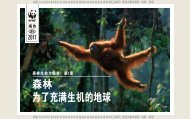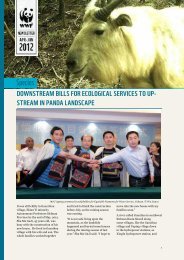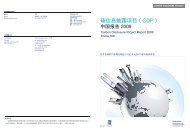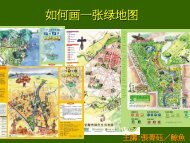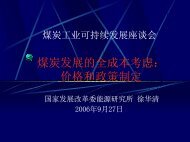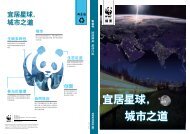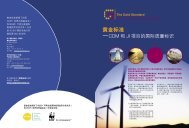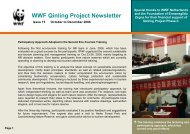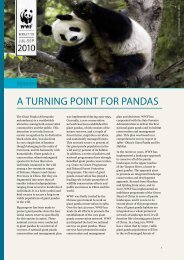Species
Species
Species
You also want an ePaper? Increase the reach of your titles
YUMPU automatically turns print PDFs into web optimized ePapers that Google loves.
Xxxxxx xxxx<br />
<strong>Species</strong><br />
Camera captured Time: 2013/05/07 00:58:08.<br />
All partners together for giant pandas<br />
On April 26th, WWF Xi’an<br />
Programme Office has organized<br />
a joint workshop, on the 2014 to<br />
2016 work planning of Qinling<br />
giant panda & giant panda habitat<br />
conservation, with its local<br />
partners in Shaanxi Province.<br />
More than 50 conservation project<br />
managers and representatives from<br />
Qinling giant panda conservation<br />
network (within which there are<br />
more than 20 nature reserves and<br />
forest farms) and the relevant<br />
administrators from Shaanxi<br />
Forestry Department have<br />
participated in this activity.<br />
© WWF China/Hao Liang.<br />
During this meeting, WWF<br />
and all the participants have,<br />
firstly, reviewed major progress<br />
and achievements of Qinling<br />
conservation programme in the<br />
past 3 years. Then, WWF has<br />
shared and introduced its updated<br />
conservation initiatives in the<br />
1
Xxxx xxxxx<br />
Xxxxxx xxxx<br />
upcoming years. Participants<br />
have also discussed the current<br />
threats and challenges on panda<br />
and panda habitat conservation<br />
in the Qinling Mountains, such as<br />
ineffective habitat management,<br />
road impacts, unsustainable<br />
community development, as well<br />
as the possible negative influences<br />
of mass tourism development and<br />
climate change issues. Meanwhile,<br />
in order to better guide and<br />
facilitate project development in the<br />
future, WWF has also formed and<br />
introduced an ‘Advisory Board’ to<br />
its partners. This Board of Advisors<br />
is a team of 9 members, consists<br />
of professionals, scholars and<br />
experts with different contributions<br />
to panda and panda habitat<br />
conservation.<br />
WWF hopes that through this<br />
workshop the local stakeholders<br />
and partners could be more engaged<br />
in WWF’s coming stage panda<br />
conservation planning in Qinling<br />
landscape and have strengthening<br />
cooperation to respond each of the<br />
challenges under WWF’s panda<br />
programme framework.<br />
Cookstove Improvement Project Launched, Ningshan<br />
County, Shaanxi Province<br />
started from June and will be<br />
finished by the end of 2014. About<br />
1300 to 1400 cookstoves will be<br />
rebuilt or modified in 14 community<br />
villages in Ningshan County.<br />
With the upcoming project<br />
implementation, WWF estimate<br />
that, more than 6000 hector of<br />
forest in Qinling giant panda<br />
conservation areas will be saved;<br />
over 1300 labors will be freed from<br />
traditional fuel wood logging; and<br />
about 1300 house wives’ health will<br />
be cared by cooking in clean and<br />
smoke-free kitchens. Moreover,<br />
more than 8000 tons of CO2<br />
emission will be reduced.<br />
WWF hopes that the project<br />
can be a great demonstration, to<br />
illustrate how government (from<br />
national level to local level), NGO,<br />
communities and individual<br />
households can work together to<br />
meet the global environmental<br />
challenges we have today. Also,<br />
WWF hoped that this partnership<br />
and community-driven strategy can<br />
accelerate conservations on forests,<br />
waters, biological diversities, and<br />
other natural resources in different<br />
areas.<br />
Retrieving Wildlife Information in Qinling Giant<br />
Panda Corridor Area<br />
© WWF China/Liu Junli.<br />
On May 10th, WWF and the People’s<br />
Government of Ningshan County<br />
have made a cooperation agreement<br />
on the Project “Cookstove<br />
Improvement for the Communities<br />
Surrounding Giant Panda Habitat in<br />
Ningshan County”.<br />
Guests and participants on this<br />
project launching ceremony<br />
included: Peter Beaudoin (WWF<br />
China Chief Executive Officer),<br />
Li Lin (WWF China Chief<br />
Conservation Director), Tang<br />
Zhouhuai (Deputy Director of<br />
Shaanxi Forestry Department)<br />
and Tian Xin (Deputy Head of the<br />
People’s Government of Ningshan<br />
County) as well as representatives<br />
from the local communities,<br />
Shaanxi Huangguanshan<br />
Nature Reserve and WWF Xi’an<br />
Programme Office team. During<br />
this event, WWF China Chief<br />
Executive Officer and the Deputy<br />
Head of the People’s Government of<br />
Ningshan County have signed the<br />
agreement contract. This project<br />
From April to June, a group of<br />
conservation managers and staffs<br />
from Huangguanshan nature<br />
reserve, Pingheliang nature reserve,<br />
Tianhuashan nature reserve,<br />
according to the work plan, started<br />
to check and collect information<br />
from more than 40 camera traps<br />
that have been placed in Caiziping<br />
panda corridor in East Qinling.<br />
In every session of this information<br />
collection activity, people have<br />
Collecting memory card. © WWF China/Hao Liang.<br />
checked cameras working<br />
conditions, retrieved digital<br />
information, readjusted some<br />
camera’s location and replaced<br />
batteries; also, updated and<br />
documented the environment<br />
2 3
Xxxx xxxxx<br />
Xxxxxx xxxx<br />
information around the camera<br />
site. For each and every day, these<br />
field staffs have to depart from<br />
the closest village early in the<br />
morning, traveling within the<br />
forests and reaching out to cameras<br />
at different places, bringing back<br />
newly captured information at<br />
dusk. During this period, they<br />
have collected a great amount of<br />
animal information, and some of<br />
this information is the first time to<br />
be seen on pictures. Besides, all the<br />
information is recorded into the<br />
database and will be used in the<br />
future for biodiversity monitoring<br />
of the region.<br />
Top: Vegetation and camera working state investigation. Bottom:<br />
Animal transect investigation. @WWF China/Hao Liang.<br />
Ecoduct Project Development<br />
Background information: From<br />
March 30th to April 2nd, WWF<br />
has organized a camera traps<br />
application training programme for<br />
its partners in Qinling giant panda<br />
conservation network, and also<br />
donated more than 100 cameras<br />
at the meantime. Sooner after<br />
this training, Tianhuashan nature<br />
reserve, Huangguanshan nature<br />
reserve and Pingheliang nature<br />
reserve have departed to the field<br />
to have the cameras setup in the<br />
region.<br />
sub-populations. In China, the<br />
study on detrimental wildlife<br />
impacts of roads and traffic is<br />
still at the beginning stage, and<br />
few experimental researches<br />
have conducted on established<br />
roadways. WWF hopes that,<br />
with WWF network and research<br />
institutions support, this small<br />
scale preliminary study and<br />
demonstration would help to<br />
reinforce the work on mitigating<br />
road impacts, and to reduce the<br />
threat of habitat fragmentation<br />
for better panda and biodiversity<br />
conservation in the Qinling<br />
Mountains.<br />
Background Information:<br />
Dongliang road is a country road,<br />
covering a total of 14.1 kilometres,<br />
in the northwest of Guanyinshan<br />
Culvert for animals. © WWF Chiina.<br />
nature reserve. The road connects<br />
Donghetai village to Liangfengya(in<br />
Foping nature reserve), and<br />
supports the economies of the<br />
communities. Since the discovery<br />
of giant living in this area and the<br />
establishment of the Guanyinshan<br />
nature reserve, the road has become<br />
a major path for panda and panda<br />
habitat conservation.<br />
Since early 2012, WWF has<br />
initiated a pilot experiment on the<br />
construction of wildlife crossings<br />
in Qinling in association with<br />
Shaanxi Institute of Zoology and<br />
Guanyinshan Nature Reserve.<br />
The project selected a country<br />
road, Dongliang road, within<br />
Guanyinshan nature reserve as the<br />
research object. By now, the project<br />
has already finished the studies<br />
and researches on the distribution<br />
of wild animals in the area, the<br />
evaluation of the roadway impacts,<br />
and the identification of possible<br />
animal passages along the roadway.<br />
The feasibility study has identified<br />
11 sites along the road that can<br />
be utilized for wildlife crossing,<br />
among which 7 are culverts and<br />
river crossings, and another 4 are<br />
overpasses. Besides, 10 warning<br />
signs will be put up to instruct<br />
vehicles that drive along this road.<br />
It is also worth mentioning<br />
that, the construction and use<br />
of roads is a direct source of<br />
habitat fragmentation, which<br />
subdivide wildlife populations<br />
into smaller and more vulnerable<br />
4 5
Xxxx xxxxx<br />
Xxxxxx xxxx<br />
Baishuihe Nature Reserve Environment Education<br />
Center<br />
Baishuihe Nature Reserve Environment Education Center. @WWF China.<br />
June 2013, Baishuihe Nature<br />
Reserve Environment Education<br />
Center, sponsored by WWF and<br />
VANCL Corporation, welcomed the<br />
first group of visitors, who were<br />
the leaders from WWF, VANCL,<br />
Sichuan Forestry Department<br />
and Baishuihe Nature Reserve.<br />
This building that designed and<br />
constructed by Dr. Zhu JingXiang<br />
from Hongkong Chinese University,<br />
was built with the pre-construction<br />
and light-steel system. This<br />
system was capable to reduce the<br />
resourcesconsumption and save<br />
the energy. Moreover, as Baishuihe<br />
Nature Reserve was located in<br />
the Longmenshan Mountain, the<br />
seismic zone, the building had high<br />
anti-quake capacity.<br />
Baishuihe Nature Reserve<br />
Environment Education Center<br />
was the third education center<br />
supported by WWF for panda<br />
conservation in Sichuan Province.<br />
It would promote the education<br />
of biodiversity conservation<br />
to the tourists and the nearby<br />
communities.<br />
Alliance Action of Anti-Poaching in Huangtuliang<br />
Corridor<br />
On May 9th, 2013, the annual antipoaching<br />
action was carried out<br />
in Huangtuliang corridor, the key<br />
area connecting the biggest wild<br />
panda group (Minshan Group A),<br />
by Wanglang Nature Reserve, allied<br />
with Forest Police Bureau of Pingwu<br />
County, Baishuijiang Nature<br />
Reserve, Wujiao Nature Reserve,<br />
etc. Through the action, the law<br />
enforcement was strengthened<br />
against poaching and illegal NTFP<br />
collecting in this area.<br />
Panda corridor is the linkage<br />
areas for wild panda and other<br />
animals to seasonally transfer<br />
from different landscapes. It plays<br />
tremendous role in reproduction<br />
for wild panda and other animals.<br />
Huangtuliang corridor is located<br />
in the junction areas of Pingwu<br />
County, Jiuzhai County and<br />
Wenxian County. According to the<br />
research, Huangtuliang corridor<br />
is the key area connecting the<br />
biggest wild panda group (Minshan<br />
Group A). Since 2003, WWF has<br />
been supporting the effective<br />
management of Huangtuliang<br />
corridor, such as monitoring and<br />
The patrolling team in the forest. © Sichuan Forestry Department.<br />
patrolling, vegetation rehabilitation,<br />
public communication, etc.<br />
During the action, two temporary<br />
tents where the collectors of wild<br />
Chinese medicinal herbs stayed,<br />
9 sets of hunting tools and 7 sets<br />
of collecting tools were destroyed.<br />
Thanks to the yearly action,<br />
the conservation awareness of<br />
communities has been gradually<br />
strengthened. It would contribute<br />
to the effective management of<br />
Huangtuliang corridor to protect<br />
the habitat for the biggest group of<br />
wild pandas<br />
6 7
Xxxx xxxxx<br />
Xxxxxx xxxx<br />
Progress Achievement on Collective Forest Management<br />
In early 2012, WWF has setup<br />
a 3000mu (200 hectare)<br />
demonstration zone composed<br />
of the collective forests of the six<br />
households in Donghe village<br />
within Qinling giant panda corridor<br />
area. This is one of the top actions<br />
on the management plan that was<br />
developed by WWF for the 1400ha<br />
collective forests of the whole<br />
village.<br />
In late 2012, the nature reserve<br />
signed agreement with each of the<br />
households, and comprehensive<br />
measures have been implemented<br />
to conserve this specific area.<br />
Within this area, 180mu gap area<br />
is planted with bamboos in this<br />
spring; by manual method, 300mu<br />
is tended to facilitate natural forest<br />
regeneration and the well growth;<br />
4 households are supported with<br />
Polyporus (high-value Chinese<br />
medicine) cultivation underneath<br />
the forest ground, with a total<br />
area of 2000 square meters; as an<br />
alternative livelihood method, 22<br />
households are supported with beekeeping<br />
facilities and techniques,<br />
with over 900 boxes being placed.<br />
In addition, the monitoring on the<br />
forest quality (as panda habitat)<br />
and the livelihood improvement<br />
is carrying on. The combined<br />
practice within the demonstration<br />
zone has been highly recognized<br />
by local communities and the local<br />
government, which also helped<br />
the project area to leverage the<br />
eco-compensation fund from the<br />
government. In the future, WWF<br />
hopes that this demonstration work<br />
can be magnified in an larger area<br />
in Qinling giant panda landscape.<br />
Bop: Handing-out bee-keeping<br />
materials; Middle: Planting polyporus;<br />
Bottom:Checking forest growth state. @<br />
Guanyinshan Nature Reserve.<br />
Panda Captured on Film in National Road 108 Qinling<br />
Tunnel Corridor Area<br />
Captured Time: 2013/05/07 00:58:13 @WWF China.<br />
Camera traps deployed on the northwest of Dongliang road (in Guanyinshan Nature Reserve) have retrieved two<br />
pictures of a panda, as well as many other animals in the area. The camera traps were placed in the area in April in<br />
order to get photographic evidence of animal movement in the area.<br />
From early 2012, WWF, in cooperation with Guanyinshan nature reserve, has setup 15 infra-red cameras and 10<br />
manual transects to track wildlife activities in this habitat restoration region. In the past, there were only tracks<br />
found. This is the first time that we have photographic evidence of pandas at this site.<br />
8 9
Xxxx xxxxx<br />
Xxxxxx xxxx<br />
Other captured wild animals on this same site include black bear, Serow, Takin, Yellow-throated Marten,<br />
Temminck’s Tragopan, Golden Pheasant and Koklass Pheasant.<br />
If there is no URL<br />
OR<br />
communicators<br />
Chang Youde, Room 1609, Wen Hua Gong, Beijing Working People’s Culture Palace, Beijing, P.R. China. Post<br />
Code: 100006<br />
Tel: +86 10 6511 6221, Fax: +86 10 6511 6222, Email: ydchang@wwfchina.org<br />
Hao Liang, Room 539, Xi Ge Ma Building, No.18 South Feng Hui Road, Xi’an, Shaanxi, P.R.China. Post Code:<br />
710075<br />
Tel: +86 29 6263 1251 Ext. 807, Fax: +86 29 6263 1252-803, Email: lhao@wwfchina.org<br />
Xiao Sha, Room 103, Building 26 Langtingyuan, Chengdu Huayuan, 8 Qingyang Avenue, Qingyang<br />
District,Chengdu Province, P.R. China. Post Code: 610071<br />
Tel: +86 28 6205 7031 Ext. 806, Fax: +86 28 62057031-808, Email: shxiao@wwfchina.org<br />
REviewers<br />
Liu Xiaohai, Deputy Conservation Director. Room 539, Xi Ge Ma Building, No. 18 South Feng Hui Road, Xi’an,<br />
Shaanxi, P.R. China. Post Code: 710075<br />
Tel: +86 29 62631252-804, Fax: +86 29 62631252-803, Email: xhliu@wwfchina.org<br />
Wan Hui, Head of WWF Xi’an Programme Office. Room 539, Xi Ge Ma Building, No. 18 South Feng Hui Road,<br />
Xi’an, Shaanxi, P.R. China. Post Code: 710075<br />
Tel: +86 29 62631252-806, Fax: +86 29 62631252-803, Email: hwan@wwfchina.org<br />
Liang Haitang, Head of WWF Chengdu Programme Office. Room 603, Wu Ding Yuan Shan Yang Zuo, No. 100<br />
Bei Er Duan, Yi Huan Lu, Chengdu, Sichuan Province, China. Post Code: 610081<br />
Tel: +86 28 6800 3625 Ext. 811, Fax: +86 28 8319 9466-808, Email: htliang@wwfchina.org<br />
Fan Zhiyong, Director of <strong>Species</strong> Programme. Room 1609, Wen Hua Gong, Beijing Working People’s Culture<br />
Palace, Beijing, P.R. China. Post Code: 100006<br />
Tel: +86 10 6511 6288, Fax: +86 10 6511 6222, Email: zhyfan@wwfchina.org<br />
acknowledgments<br />
Special thanks to WWF Netherlands, WWF-Switzerland, Fondazione Zegna and EU for their financial supports<br />
to the Qinling Project Phase III, WWF UK, WWF US, WWF Germany and WWF Sweden for their financial<br />
supports of Minshan Initiative, and WWF Netherlands, WWF UK, WWF US, WWF Germany, WWF Sweden,<br />
WWF Switzerland and WWF Canada for their supports of the Green Heart of China Programme. Sincere<br />
Why we are here<br />
thanks to the To Coca-Cola stop the Company degradation for of WWF-TCCC the planet’s Partnership, natural environment WWF Network and and WWF-US Humanitarian<br />
to build a future in which humans live in harmony and nature.<br />
Partnership Programme for making efforts to post-disaster reconstruction plans, and Carrefour for Sustainable<br />
Management and Development Project for Medicinal Plant Resources.<br />
• The Green heart of china Programme • April - June 2013 WWW.WWFCHINA.ORG<br />
With URL - Regular<br />
Why we are here<br />
To stop the degradation of the planet’s natural environment and<br />
to build a future in which humans live in harmony with nature.<br />
www.panda.org<br />
Legal text here ipsum dolor sit amet, consectetur adipisicing elit, sed do eiusmod tempor incididunt ut<br />
labore et dolore magna aliqua. Ut enim ad minim veniam, quis nostrud exercitation ullamco laboris nisi<br />
ut aliquip ex ea commodo consequat. Duis aute irure dolor in reprehenderit in voluptate velit esse cillum<br />
10 11<br />
dolore eu fugiat nulla pariatur. Excepteur sint occaecat c culpa qui officia dese. wwf.org.uk



